Right Tool for the Wrong Jobs
Update as of July 14, 2023:
I ended up buying the Gerber StrongArm noted below, black, plain edge. It has proven to be durable and it’s much more lightweight than the Becker, which is now my truck knife. The handle has a lot of grip and while showing some wear probably has a few decades left in it before it needs replaced. Still not a fan of the non-replaceable handle but for the price and durability I’m fine with it. Fits my hand nicely and is reasonably sharp from the factory.
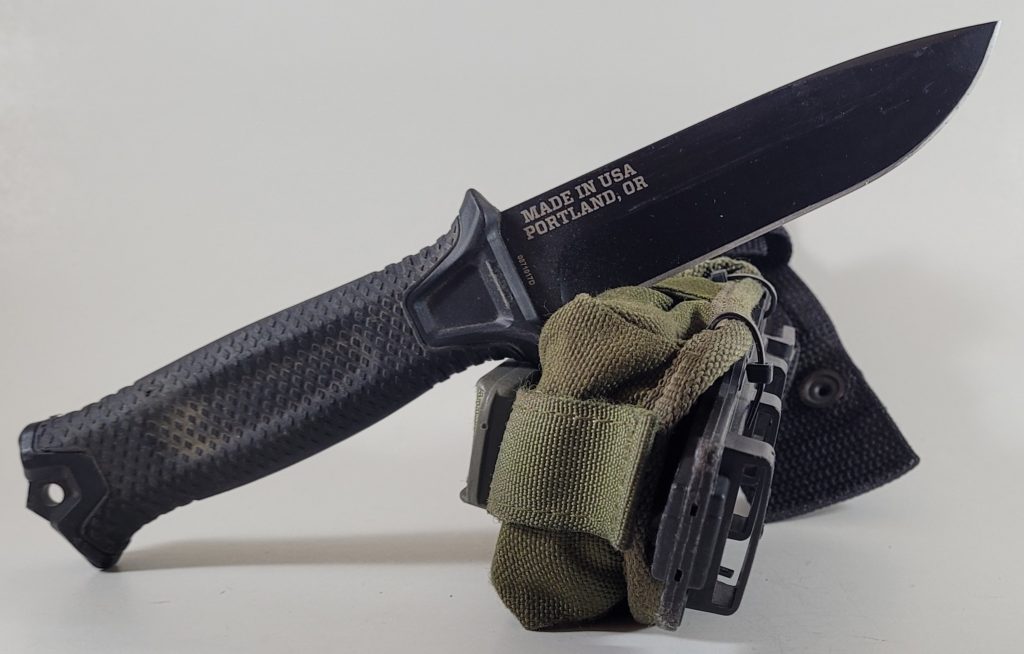

Like many people stuck in an over civilized world, I sometimes need something unruly, slightly dangerous, and perhaps a bit in-your-face to disrupt the monotony. I could wax philosophic for hours on how this is why we have a proliferation of test-your-mettle events and “survival” shows on TV. If you’ve read anything else I’ve written you know this isn’t an empty threat… Think about it: How many people do you know who proudly, if generally incorrectly and doubtfully tested in any way, claim that they can light a fire with – hold on, I have to take a deep breath – two sticks, two sticks and a rope, belly button lint and Vaseline, Chapstick and cotton balls, a 9V battery and steel wool, magnesium and flint, some oily-wood-handle for tinder south American fire steel you see at 4×4 shows, zip-lock bag and water, etc. If you said every guy you know, you’re probably right. Now, how many of them actually know how to use any of those items, let alone have done it more than once? Right? It’s a card trick for the bored. That said, many of us do like to get out there and see if we can get into trouble, and when that happens, we want to have with us exactly what you think this article is going to be about: Knives.
Don’t worry, I’ll just copy and paste that first paragraph for my fire-steel review, but for now I was just having fun making a point for no reason. But seriously, when you’re out and about a knife is really handy to have. 90 percent of the time you’ll use it to cut onions or slice sandwiches in half, but there is that one time you may have to cut off your leg to effect self-rescue…
So that said, for a multi-sport type of guy what type of knife would I want to have? The world of knives is insanity in a leather or kydex sheath. How many different ways can a pointy piece of metal be attached to a roundy piece of handle, honestly? Too many. But let my wasted time and money be a boon for you and yours so you don’t have to be an idiot like me.
First things first: I always carry my Leatherman, so that doesn’t count. It may be in a dry bag at the bottom of my pack during a water crossing, but it’s there, ready to slice off a piece of summer sausage in an emergency.
What I want is a knife in a sheath, ideally nylon/kydex retention style, attachable to my person somewhere handy, which I can use and abuse and not worry about scratching the finish or dulling the blade. This can’t be a collectible fantasy knife made of Damascus(esque) steel.
My first knife of sorts was a real Swiss Army knife, bought in Switzerland by my sister of which I still have and hold in high regard today. But I never liked using the knives because they were too small and frankly, it was a keepsake of sorts.
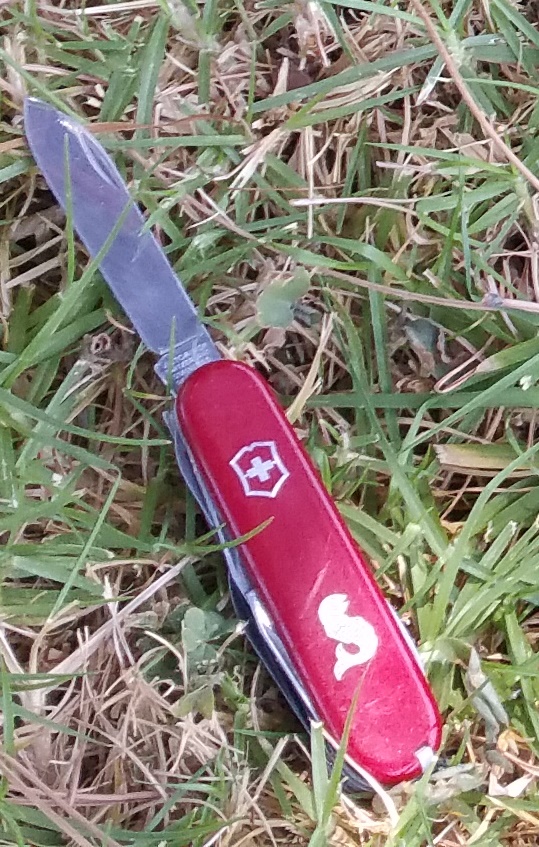
Gerber Fisherman
My first real attempt at a general utility backpacking/hiking knife was a Gerber rafting knife from the Blackie Collins collection.
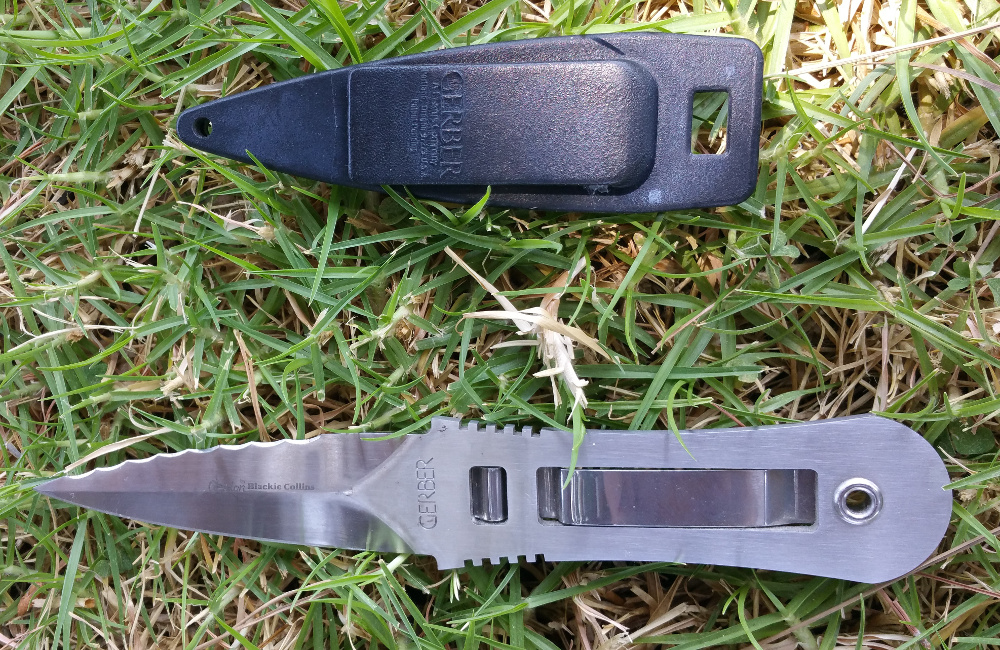
Beautiful in its simplicity, no moving parts, all one shiny piece of steel, it was a sight to behold. Pretty sure I begged my mom to buy it for me in my 20’s while home from college. Probably something like that, I’ll have to ask her. Super sharp and completely impractical for any real use, at least in my meaty hands. There’s no stop between the handle and blades other than some sharp-edged jimping at the end of the handle. Being a double edged blade you can’t ever touch the working end of the tool without losing some life-sauce.
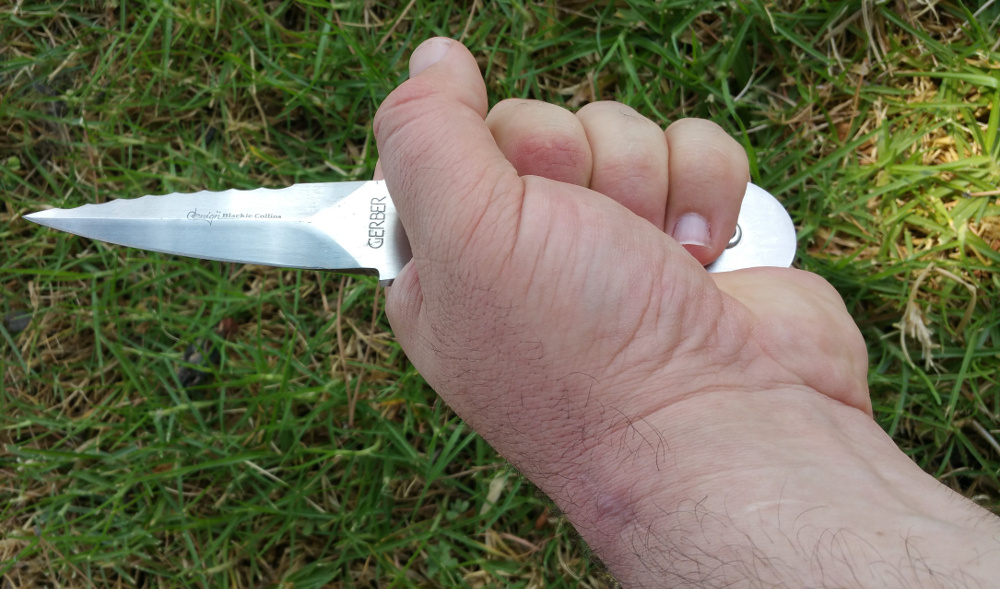
Gerber River Guide Blackie Collins
Also, since the retention is one sided and stiff you’re limited on methods to remove the knife. That said, good, positive retention, ain’t never coming out without a ton of effort.
I was once asked to prove this and right as I finally pulled the knife out someone walked up by my arm in slicing range and I hastily tried to put it back into the sheath. I was successful on the 2nd try, with the 1st giving me 3 stitches in the meat between my finger and thumb. Lovely art piece, impractical and unsafe. I’ll never get rid of it, too many memories. Plus, getting rid of a knife is like burning a book or tossing a bible – some things you just don’t do without a lot of thought.
After some research based in ignorance I moved onto dive knives. Specifically the the Ocean Master Beta Titanium Blunt Tip knife
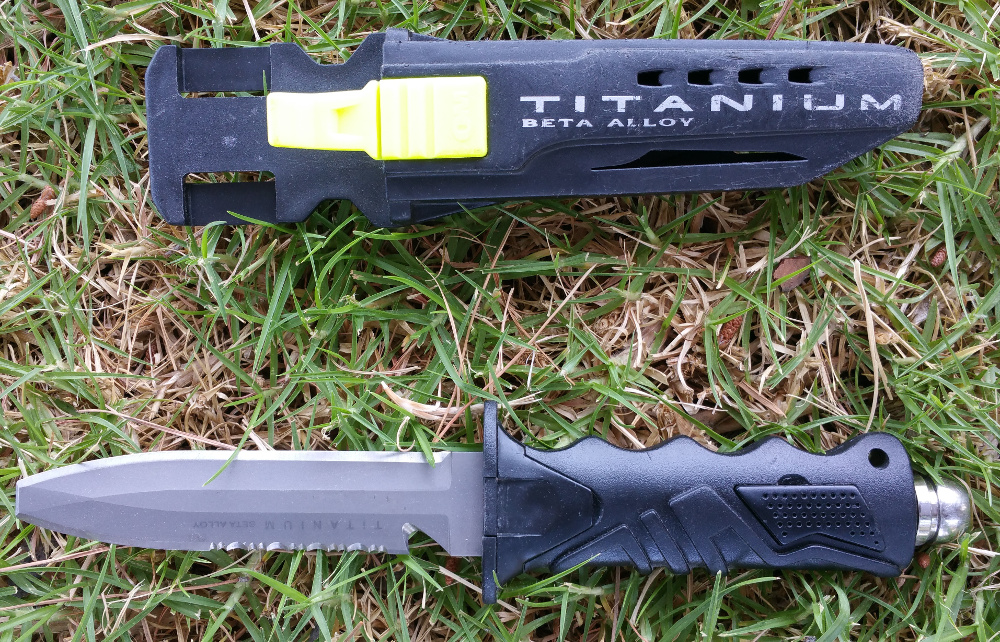
Talk about positive retention. Full handle, obviously waterproof, metal butted pommel for hammering things, these things rock. For diving. Not as much for hiking, although they’ll do the job. Main problem is the double sided blade, just worthless for the tasks above water, if possibly necessary for aquatic adventures. Also, I went with the Titanium model which is a bear to sharpen, if lightweight and strong. I have little doubt that when I finally go diving this will prove invaluable but until then it sits forlorn on my activities wall.
After more research I discovered that a true “survival” knife needs to have just a few simple qualities: A full tang, good handles (or replaceable), quality steel with a number attached, and a solid sheath. Most other features are gimmicks. Note that the best tool for survival is the one you have on you and which works. Again, the fancy do’s and don’ts of survival simply come down to using what’s there and what works. For me, for the moment, that’s the Ka-Bar Becker BK2 Campanion.

Odd name and from what I recall Ka-Bar, the company which was the originator of the famous “Kabar” WWII knife bought a newer brand named Becker Knife and Tool. Hence the long name, simply the combination of the two. I think they were trying to be clever with the name by combining “companion” and “camping”, given the utility and typical use.
The aforementioned full tang is for strength. It’s why a pair of pliers breaks before a pry bar: A solid section of steel is just stronger. Simple physics. It’s a limitation on space since you can’t fold it, but a folder is only as strong as the hinge. Folders absolutely have their place – look at how much I swear by the Leatherman – but there are some tasks for which I just prefer to use a better tool, such as anything extremely messy or involving chopping. I tend to split kindling with my knife when I don’t have a hatchet, and that’s a stress on any knife, let alone a folder.
The handle on this is somewhat slick and would be better in another material, but it has proven to be tough, having been exposed to every condition I can think of, from below freezing to asphalt melting temps and a few things in between. Really doesn’t slip out of my hand too often so I’ve never replaced it, although I could if I so chose. One handy thing in this regard is the heavy curve at the pommel, which when combined with a leather glove means retention is likely even with a loose grip. Without the leather gloves I tend to get hotspots which could lead to blisters after a lot of chopping, but at that point I usually bust out the hatchet or the axe.
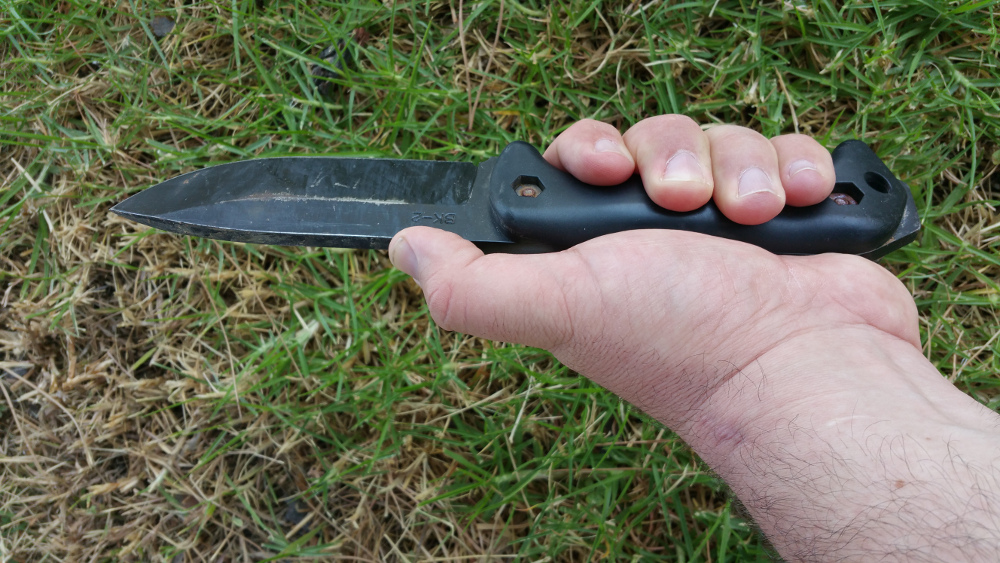
The steel on this one is 1095 Cro-Van which basically means it holds an edge relatively well but when it does eventually dull it doesn’t take a lot of work to return the edge back to full sharp. However, it will rust if it rains 3 miles away. The issue with rust isn’t too bad, just requires a dab of oil here and there and doesn’t hurt the edge terribly when you forget. That said, it’s not the best saltwater blade.
You can get lost in the world of metal types, but it comes down to a few basic principles from a layman’s perspective. Super hard metals hold an edge well but are impossible to sharpen in the field without special tools, like the titanium dive knife. Super soft metals require a lot more sharpening but that can be done on a local rock if the mood strikes. And then there’s the world in-between, trying to find that perfect compromise of the two.
Note that I’m misusing words here: Sharpening versus Honing. If the edge of your knife has some dull spots, it just needs to have the metal guided back into place gently, usually on a steel or similar surface. If the edge is flat, pitted or chipped, you have to sharpen it by grinding and physically removing metal. You don’t want to grind very often if you can avoid it.
Speaking of the blade, this thing may as well be a leaf spring hammered into a knife Rambo style. At a full .25” thick it’s half again thicker and heavier than almost anything else you’ll use. On the plus side, you’re not breaking this anytime soon. Then again, at a full pound of heft, it might break you first. And that’s the first of several downsides with this knife.
Dang thing is heavy. What you don’t notice at first become laborious after 15hrs of hiking and you feel every ounce of it dragging you down. Less an issue for my sizeable stature, perhaps more for those of less obelisk-like features.
The plastic sheath is almost always awesome and has great retention. I frequently dangle it upside down and forget the safety snap and have no fears of it falling out. Has never happened in years of carrying. Heck, I strapped this to the outside of my saddlebags on a dual sport ride from PA to CA in all conditions and it didn’t budge.
However, don’t try to use it in the winter. If you’re hiking in the snow it just does not want to release. It will, but your thumb will hurt from pressing on the release section and you’ll have to apply dangerous amounts of pressure. Doable, since I do it, but something to contend with in below freezing temperatures.
Speaking of the sheath, it’s molle compatible by technicality but you’re probably never going to do that so, yeah, me neither. The handle snap works but is stitched in place, as is the belt loop, both of which are annoying. Had I a sewing machine and the ability to use it I’d slice things up and replace with some Velcro.
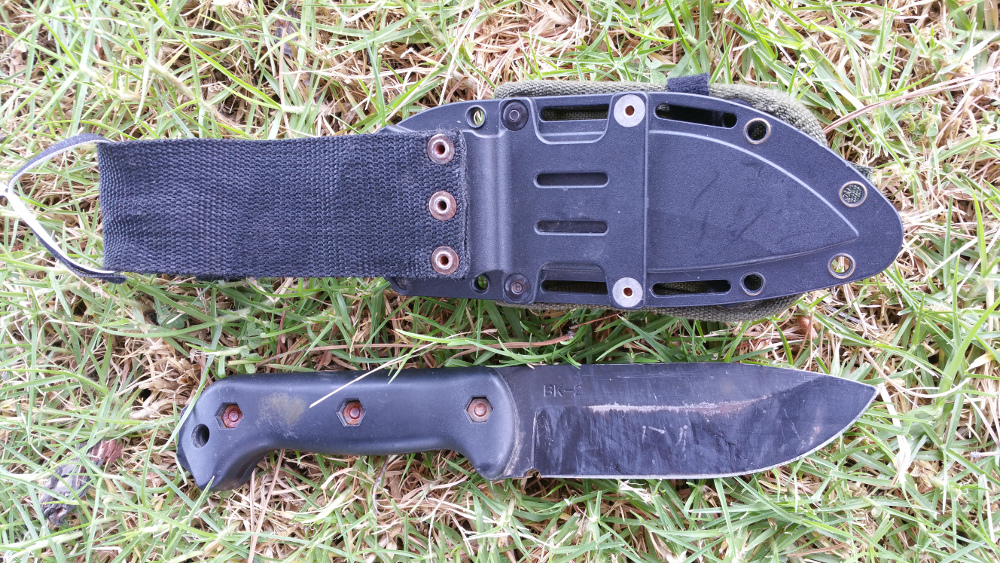
I use this knife every time I go out in the wilderness and it has proven itself from cutting vegetables to splitting wood. Along with my tin filled with cotton balls, Vaseline and a firesteel (which I use as my primary means for lighting campfires and my stoves, stored in the green pouch on the sheath), it’s an indispensable tool, especially for the typical sale price in the $60’s. I should note that this has the tacticool black blade coating which, while probably handy for Navy Seals, is not only worthless to me, it’s a hindrance. I can’t use the spine of the knife to throw sparks because of that coating. I have plans to grind it off in the near future to add more functionality to the blade. That said, I have plans for making it my car knife (or possibly motorcycle knife) due to the weight and finding a slightly lighter knife in the same form factor, since that weight does become a factor over time.
What other blades am I considering?
Offhand, these top my list
Gerber Strongarm: $60-100, carbon steel, positive retention, good handle, good sheath. Don’t like the non-replaceable handle, but destruction tests seem to not phase it.
Schrade SCHF9: $40, good sheath, carbon blade, don’t like the recurve blade.
Schrade SCHF3N: $45, ok sheath, don’t like the stainless blade, micarta handle, like the blade shape.
ESEE-6 with Kydex: $150 premium, I like kydex, supposedly a great blade but $150…
There are two other knives worth mentioning here because I’ve used and carried both, but neither is my go to for a variety of reasons but both could readily be yours if your preferences align.
First up is the Buck Folding Alpha Hunter in Rosewood Handle.
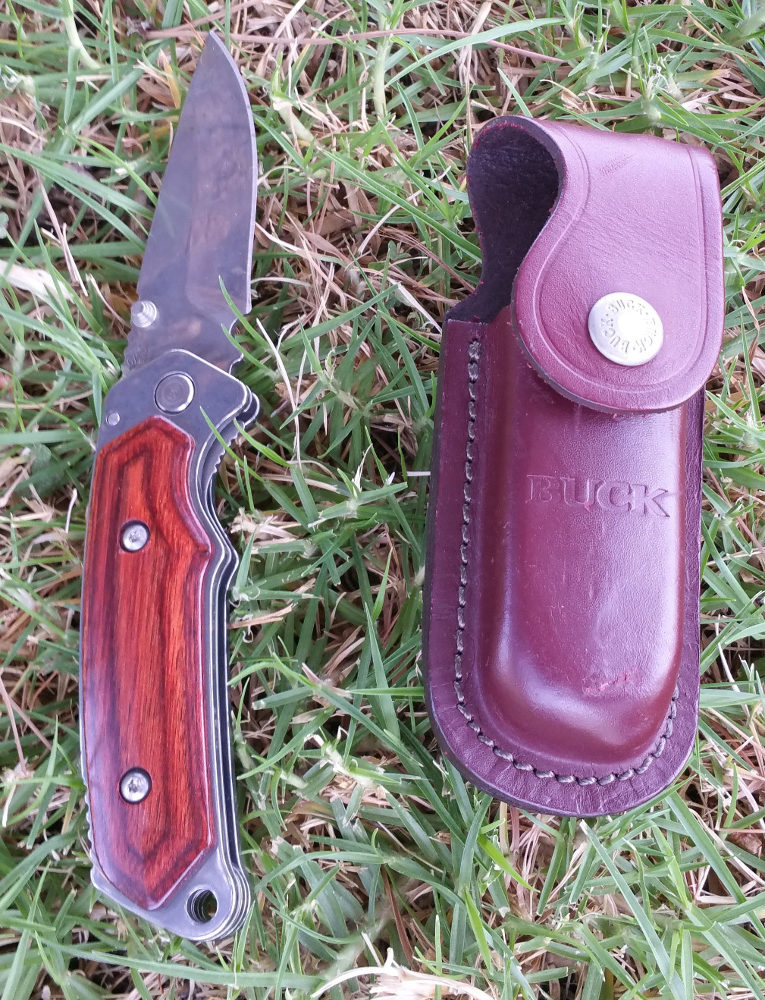
This was a gift from my dad and what can I say, it’s sharper than stink and mantle-worthy to boot, down to the leather sheath. It fits perfectly in my hand, has a positive feel overall and is just about the perfect length to use.
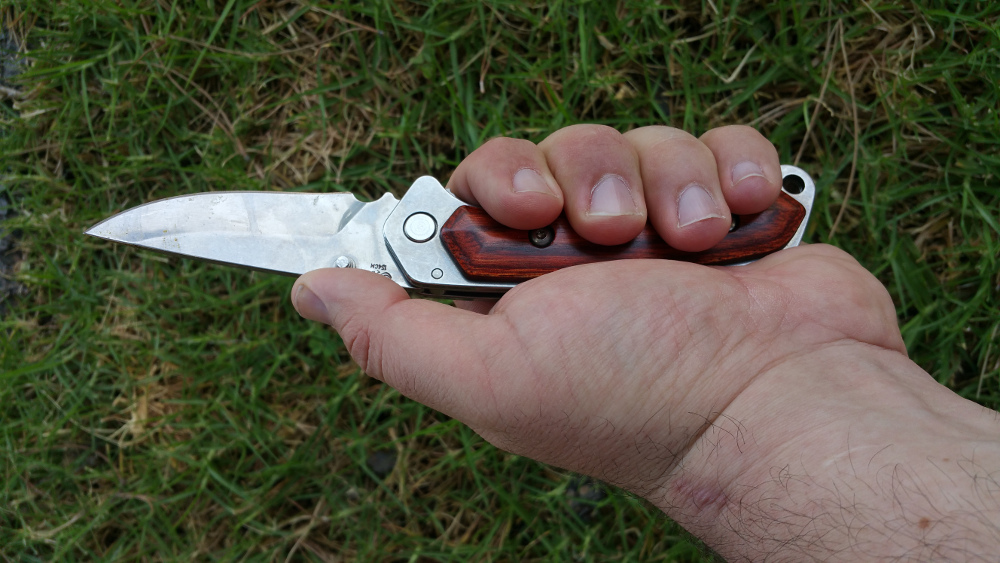
The primary reasons I don’t carry it more are because I always have my Leatherman on me so I have access to a smaller, general use blade, I prefer a solid tang blade over a folder, especially when it comes to cutting sloppy stuff, and it’s almost too beautiful to use. I always feel a little bad about not using it because it was a thoughtful gift which just flat works perfectly, just not quite for how I typically use knives. It’s probably $150+ with the rosewood and leather sheath, less if you get the standard kit. If you’re a fan of folders, this is a very good choice.
Next up is the Mora 511.
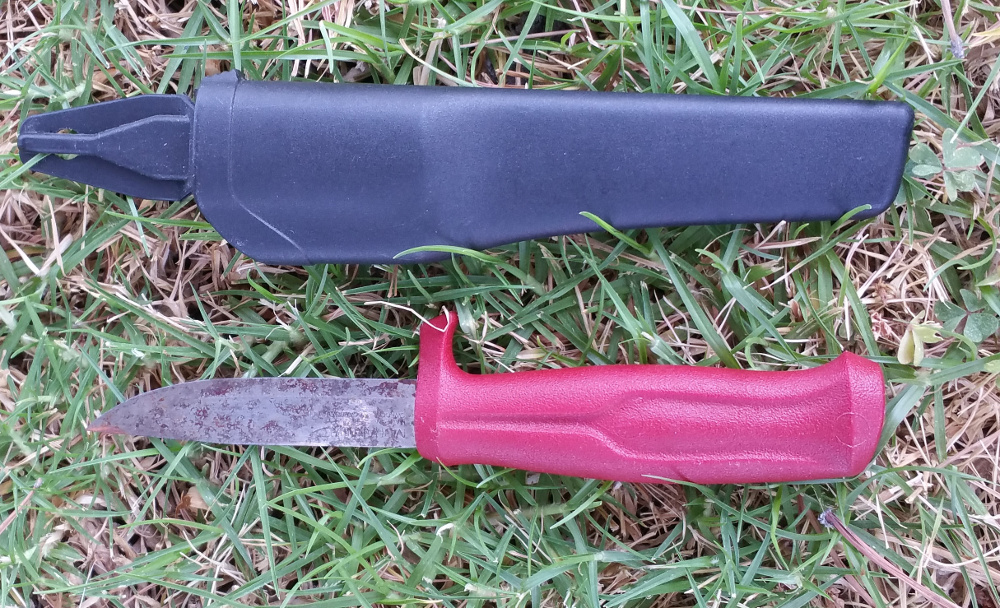
I could pretty much say Mora “insert any of their knives here” because they’re all pretty much perfect for what they’re built to do, plus an extra 30%, but I bought the cheapest of the cheap because, well, I’m cheap.
For $10 I could literally say that this knife doesn’t suck and that would be good enough. But it goes beyond that. First, it comes with a useable hard sheath. The only downsides with the sheath are that the belt loop holes are tiny and difficult to get anything but a flimsy nylon belt through and that it doesn’t have a positive retention system. This means I can’t put the sheath on my leather belt and don’t trust it enough to store upside down or anywhere I think it could be pulled out by outside forces. However, it stays nicely in the sheath and has never given me any significant issues with coming loose. To be fair, in prepping for this review I dropped the knife in the holster on the carpet and it pulled out by 3″, with the blade still in the sheath, but barely. Note again though, it’s a $10 knife and the sheath alone would probably cost that after-the-fact.
The plastic handle does its job and I love that little finger hook at the end. No chance of sliding a finger onto the blade.
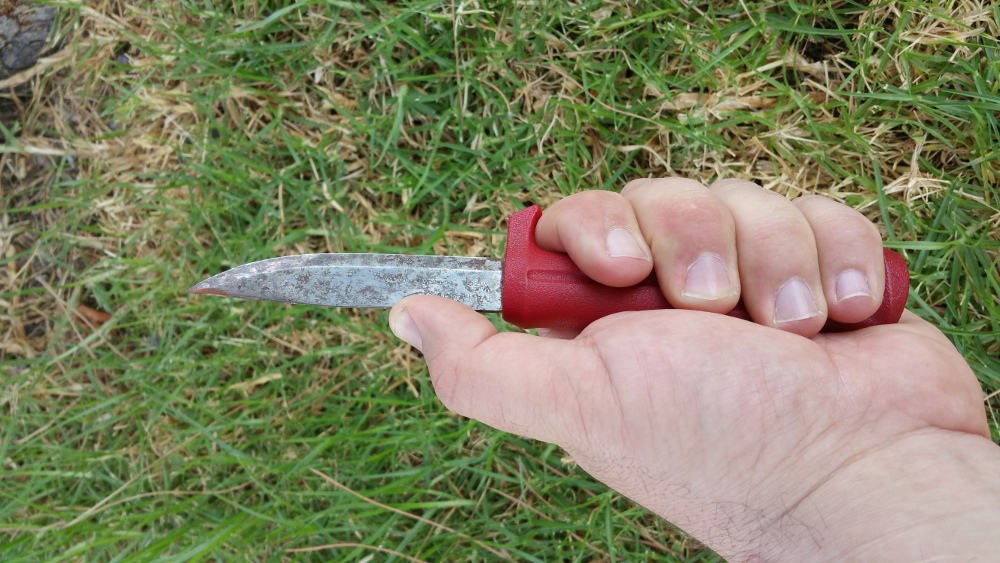
Speaking of the blade, that’s where Mora shines. Their knives are deadly sharp from the factory and tend to stay that way longer than they should. With the 511 being standard carbon steel it rusts for the sheer pleasure of it, but I’ve found that the blade stays sharp and the rust just forms a nice patina. Your more skittish friends will look at you with worried eyes when you’re using it to cut fresh veggies, but I think it’s fine. I should note that most of the patina on my is because I pretty much exclusively use it as my fishing knife, much of which involves salt water, which will rust a blade before it leaves the factory.
If you read the good knife forums, the Mora Knives will always be at the top of the list, simply because they’re cheap enough not to worry about yet take a beating. As the wisest people say, the tool you have on you is the best tool you have and at $10 you’ll probably take this with you everywhere, even if the bottom of the bag. They don’t meet some of the baseline standards of the “survival” lists, but they operate more closely to that list than they have a right to, at a price too cheap to be reasonable. By five of these, stash them here and there and everywhere and always be prepared.

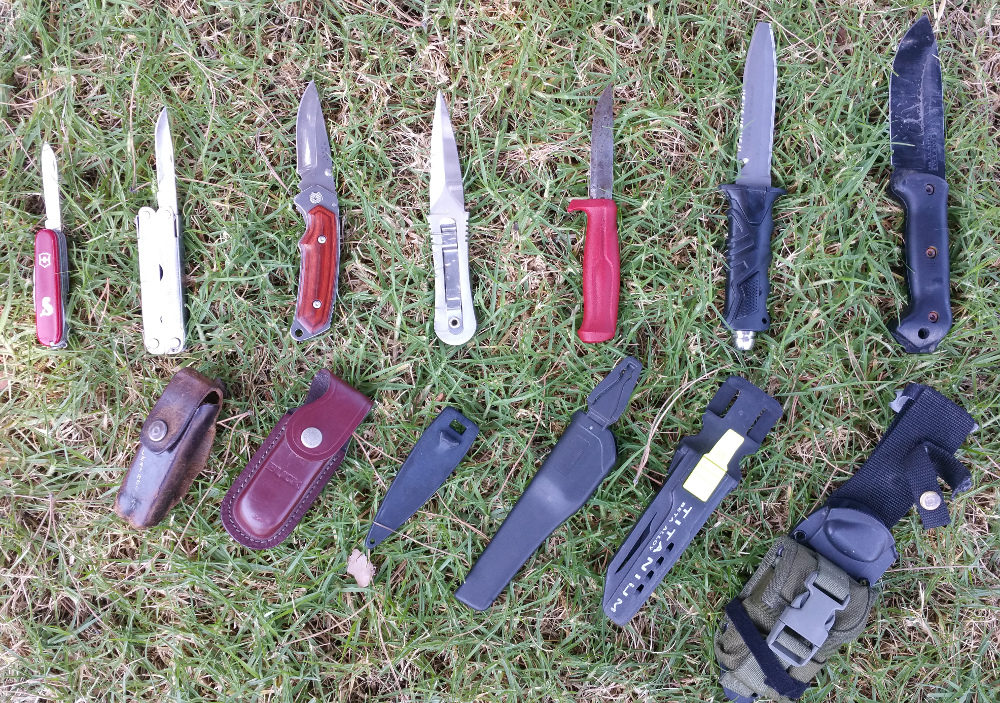




Comments are closed here.